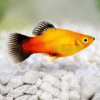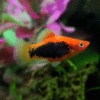-
×

-
×

-
×
 Purple Vampire Crab - Geosesarma Dennerle - Decapod Crustacean
4 × £7.74
Purple Vampire Crab - Geosesarma Dennerle - Decapod Crustacean
4 × £7.74 -
×

-
×

-
×

-
×

-
×

-
×

-
×

-
×
 Assorted Colour Vampire Crab Geosesarma Sp 2-3Cm
2 × £8.71
Assorted Colour Vampire Crab Geosesarma Sp 2-3Cm
2 × £8.71 -
×

Subtotal: £442.57










Emily Carter (verified owner) –
I recently added 4 Blue Wagtail Platies to my community tank, and I couldn’t be happier! These little guys not only add a splash of vibrant color but also have such delightful personalities. I’ve been an aquarium hobbyist for over five years, and I’ve had my fair share of platy fish, but this variety stands out with their stunning blue tails and lively behavior.
After about two weeks of keeping them, I noticed them exploring and interacting with each other and my other fish like they were old friends. They seem to thrive on the high-quality fish food I’ve been using, which includes a mix of flakes and live food. One thing I appreciate about these platies is their hardiness; they adapt well to different water conditions and are a great breeding fish for those looking to expand their tank family.
While they do enjoy a bit of space, they are quite peaceful and get along with most of my other fish. If you’re considering adding platies to your aquarium, I highly recommend this colorful variety. They’re perfect for both beginners and seasoned aquarists alike. Just remember to monitor water quality regularly, as it’s essential for their health. Overall, I’m delighted with this purchase and would definitely buy from this seller again!
Emily Carter (verified owner) –
I recently purchased 4 Blue Wagtail Platies, and I couldn’t be happier! As a caring fish parent, I truly appreciate how vibrant and lively these little guys are. They arrived just a week ago, and have already settled beautifully into my 20-gallon tank. Their stunning colors bring so much joy to my aquatic environment, and watching them swim around in pairs is simply delightful.
One of the things I love about these freshwater fish is how easy they are to care for. They adapt well to different water conditions and are very peaceful, making them perfect for a community tank. Compared to other platies I’ve had in the past, these Blue Wagtails have such a unique and striking appearance. Plus, they are known to breed easily, making them a great choice if you ever want to add more to your collection!
A minor consideration is that they can be a bit shy initially, so it’s important to provide plenty of hiding spots in your aquarium. Overall, I highly recommend these tropical fish for beginners and seasoned aquarists alike. They truly add life and color to any tank, and I will definitely be purchasing more in the future!